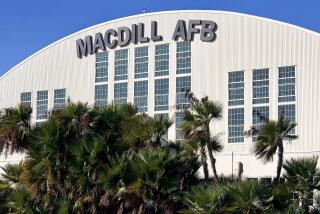Base Digging for Possible Chemical Agents
- Share via
Concerned that World War II-era trenches at Edwards Air Force Base could contain mustard gas and other chemical warfare agents, the military will begin a $4.5-million cleanup effort next week near a group of airmen’s dormitories, officials said Wednesday.
The four buried trenches--part of a chemical storage yard that closed in 1946 on the sprawling base north of Lancaster--were discovered a few years ago as the Air Force made plans to build the dorms about 25 feet away, Edwards spokesman Gary Hatch said.
Scientists found no evidence of hazardous materials in the soil around the trenches at that time, Hatch said, but the Air Force now wants the trenches excavated.
The cleanup will take about five months, he said, with crews working inside a specially constructed mobile tent equipped with air filtration systems. The soil will be placed in a lined dump on the base’s testing ground and any hazardous materials will be placed in metal bins and stored in a warehouse on the base, far from regular activities.
“We’re proceeding like there might be some materials in there,” said Hatch, who added that no personnel would be relocated during the process. Money for the cleanup will come from a U.S. Department of Defense fund for environmental cleanups, he said.
Lyle Talbot, a member of the local environmental group Desert Citizens Against Pollution, said he believes the chances of finding chemical warfare agents are pretty high. Air Force records indicate that the yard may have contained the blistering agents mustard gas, lewisite and phosgene, as well as the choking agent chloropicrin.
Talbot, a former member of the base’s Restoration Advisory Board, said no records have been uncovered that prove the chemicals were destroyed: “They just apparently disposed of them in the trenches.”
Edwards officials said military records from the 1940s show that the base didn’t have the personnel on hand to close the chemical yard properly, but they are not certain what actually happened.
Though the U.S. Armed Forces have not produced chemical warfare agents since 1991, authorities and communities across the country are still dealing with their complicated legacy, said Craig Williams of the Chemical Weapons Working Group, a Kentucky-based organization that advocates cleanups of stockpiles.
The Army is working on plans to dismantle its eight chemical weapons stockpiles in the United States, said Larry McCaskill, spokesman for the Army’s Aberdeen Proving Ground in Maryland, where 1,600 tons of mustard agent have been stored since World War II and are soon to be neutralized.
On the campus of American University in Washington, D.C., the Army is removing chemical warfare agents left from tests conducted there during World War I, Hatch said.
Steve Kornguth, director of the University of Texas’ Biological and Chemical Countermeasures Program, said it is possible that the 50-year-old chemicals at Edwards or elsewhere may no longer be a health hazard. But Talbot, who said he has been fighting for the cleanup since the mid-1990s, said it’s important for the Air Force to do the right thing at Edwards.
“There are a number of offices within a quarter-mile of the site,” he said. “Now, it’s a chapter we can close.”
More to Read
Sign up for Essential California
The most important California stories and recommendations in your inbox every morning.
You may occasionally receive promotional content from the Los Angeles Times.













